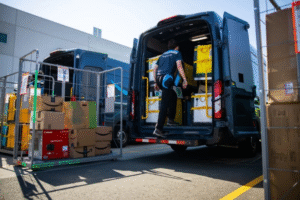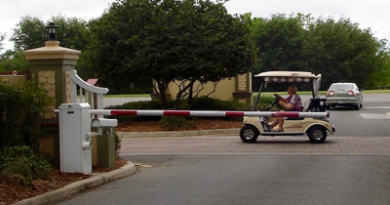Infrastructure from the Family Business to Urban-Based Multi-Modal Distribution Hub
How do family businesses relate to urban multi-modal distribution hubs? Both are part of a market infrastructure. Many golf car dealers have been handed down often from two to three generations. Multi-modal distribution and transportation systems, on the other hand, especially in densely-populated urban areas are usually the product of public-private investment projects. In this article, the case is presented that the latter may be a great business opportunity for the former.
Multi-modal systems often lack a key ingredient in serving the public
Multi-modal systems are mainly focused on tying together the subsystems of rail and municipal transit systems. Implemented through bus and trucking services, such systems often lack the ability to get goods and services to final customers in a convenient, efficient, and timely way.
In the age of e-commerce and same day delivery services enjoyed by suburban residents, urban center residents are still lacking these benefits. But major changes may be on the way.
Last mile, same day delivery systems on steep growth track

A recent article in the e-newsletter, Supply Chain Dive, featured a story about the expansion of same day delivery systems by Walmart, Amazon, and, Target. This is a logical progression from Big Box stores—essentially retail warehouses—to doorstep delivery to the customer. In large part the companies are responding to significant increases in their e-commerce business and the competitive attractiveness to consumers of quick delivery of the ordered item.
Target is implementing its strategy across a wide range of U.S. cities., and in Dallas, TX the company has invested in a fleet of Chevrolet delivery trucks, which are electric powered. The fact that these vehicles, 35 of them, are electric-powered required a charging system and fleet management system. The steps taken to put things together could serve as a model for selling and promoting the use of golf car-type utility vehicles in these networks.
The collaboration needed to complete the system
Supplying the vehicles is one thing but clearly insufficient to implement the full system. To do this GM connected with two independent specialist companies to furnish the drivers on the one hand, and the charging system, on the other. The two companies are Frontdoor Collective and Circuit EV Solutions, respectively.
As the Supply Chain Dive article notes, “The retailer is adding the delivery capacity thanks to an arrangement with the Frontdoor Collective and Circuit EV Solutions. Through a “fleet subscription program,” the Frontdoor Collective staffs the BrightDrop vehicles with drivers through its franchise delivery model, while Circuit EV Solutions manages charging infrastructure and fleet support, per the release.
Gretchen McCarthy, Target’s chief supply chain and logistics officer, wrote on LinkedIn, touts the collaboration: “Our new electric vehicle partnership with The FRONTdoor Collective is an exciting example ofthat — higher capacity delivery vans that reduce carbon emissions.”

The article goes on: “Executives with the Frontdoor Collective, Circuit EV Solutions and General Motors said the EV program will help customers make deliveries more sustainably while removing obstacles for electric delivery at scale, such as finding adequate charging infrastructure. “This alliance removes the historic roadblocks to electrifying last-mile delivery,” Dan Bourgault, CEO at the Frontdoor Collective, said in the announcement. “With the launch of this comprehensive solution, we now have the vehicles and infrastructure, and the trained workforce ready to go.”
Golf car manufacturers have much of this know-how, plus the vehicles in-house
Looking at the pieces of this last mile delivery system, we see big box store Target as the organizing entity and putting together the two collaborating companies for on the ground implementation.
In their fleet management products golf car manufacturers furnish both the vehicles and the control systems. It suggests that the market opportunity is identifying and approaching the retailers that are looking to enhance their local distribution systems—much as Target is doing.
GCT vehicles are a good for urban centers
Last mile delivery is not a brand new concept. It took off about five years ago during the COVID pandemic. What are the growth prospects and where can golf car-type vehicles fit in? To answer the latter question first, densely-populated urban centers are the most likely environments for GCT vehicles.
The combination of their relatively small footprint, adequate range, and substantial load capacity would appear to make them a good fit in crowded urban centers.
Why are the growth prospects for last mile delivery in urban centers?
To answer the second question posed above, a clear indicatory of a positive growth outlook is the fact that a number of cities, including New York and Chicago at in the process of converting office high rises into residential housing units.

Courtesy of Smart Cities Dive, “Apartment conversion projects “accelerated at an unprecedented pace” across the U.S. in 2024, according to a new RentCafe report. Last year, nearly 25,000 apartments were completed via adaptive reuse, up 50% compared to 2023 and double the amount of such conversions in 2022.
This appears to be an on-going trend and would have major implications for the distribution of consumer goods and services. This is highly likely, particularly in the context of growing e-commerce purchasing. As urban centers become more populated, big box retailers, such as Target, will follow suit by locating their warehousing centers as close to the customer as they can and use fleet carrier systems to et to the final customer.
Strategic initiatives and needed
To take advantage of this growth opportunity, GCT manufacturers and dealers will have to break the mold of their usual way of doing business.. Developing this market will require an active outreach to big box suppliers and restaurant chains, companies that would be the primary coordinators of last mile, overnight or same day deliveries.
Small Vehicle Resource will be conducting a survey of GVT manufacturers and dealers to see whether this market is on the radar and to what extent. Stay tuned and see SVR’s latest comprehensive report on the industry.
________
Contact the Author: Steve Metzger at smetzger@smallvehicleresource.com. Or check out our website at www.smallvehicleresource.com, where you will find an extensive database of vehicle models and can make side-by-side comparisons of vehicles based on a full set of specifications.


